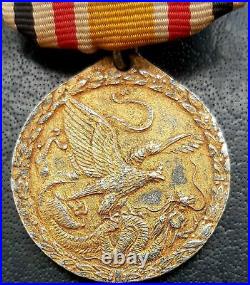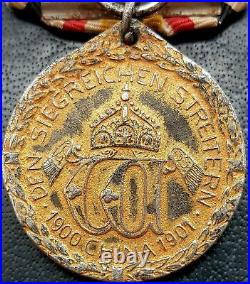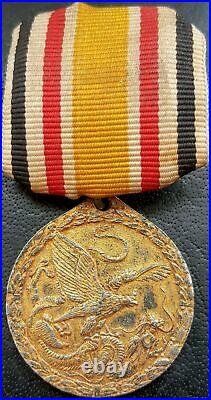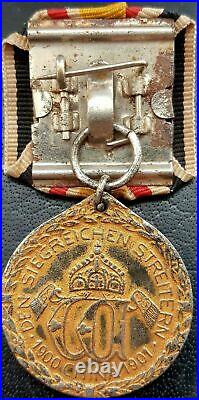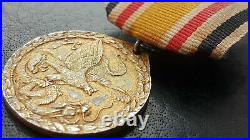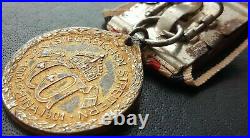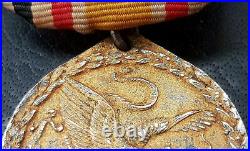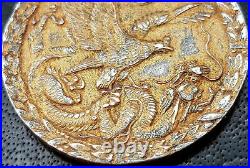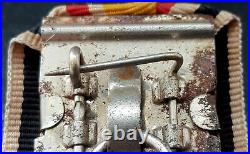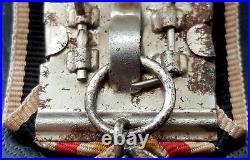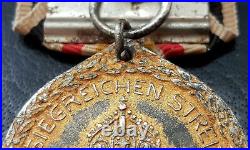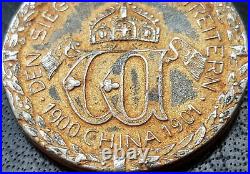Original pre WW1 German mounted China Campaign Medal (China-Denkmünze) – 1902, THE AWARD IS IN GOOD WORN CONDITION WITH PARTLY LOST FINISH, ON GENUINE RIBBON , INTACT PIN DEVICE, A FINE UNCLEANED EXAMPLE, A RARE AWARD. HISTORY OF THE AWARD. China Campaign Medal (China-Denkmünze) was instituted on May 10, 1901 by the German emperor and king of Prussia Wilhelm II as a decoration of his subjects regardless of gender who participated in suppression of Boxer Rebellion (also known as Boxer Uprising or Yihetuan Movement) between May 30, 1900 and June 29, 1901. The following categories were eligible for China Campaign Medal: military personnel of army and navy; non-combatants, i. Frontline soldiers were decorated with China Campaign Medal for military personnel (China-Denkmünze für Kämpfer) that was made of brass or gilt copper. China Campaign Medal for non-combatants (China-Denkmünze für Nicht-Kämpfer) made of polished steel, silvered brass and silver was awarded to non-combatants. Silver medals were unofficial having been struck by private manufacturers. Design of the medal was made by a sculptor from Berlin Walter Schott (18.09.1861 02.09.1938) based on a project prepared by Wilhelm II himself. China Campaign Medal is a typically drop-shaped one, 35×32 mm with a hole for suspension in its upper part. Obverse of both types of medal was encircled by a laurel wreath and showed an allegoric composition of a victorious crowned German eagle with spread wings holding a defeated Chinese dragon in its claws. Reverse of the China Campaign Medal for military personnel was encircled by a laurel wreath and had a crowned cipher of Wilhelm II placed in the centre and two inscriptions: To the victorious fighters (Den Siegreichen Streitern) in its upper part and 1900 China 1901 below. Reverse of the China Campaign Medal for non-combatants was encircled by a laurel wreath and had a crowned cipher of Wilhelm II placed in the centre and inscription For the service during an expedition to China (Verdienst um die Expedition nach China) as well as a small five-pointed star at the bottom. Ribbon was white with central wide yellow vertical stripe and two thinner black and red stripes at both edges. Approximate number of awards: 50,000 (combatant medal) and 6,000 (non-combatant medal). Battle clasp could not be worn with the non-combatant medal and even if non-combatant was theoretically eligible for a honour bar according to his service records he or she was decorated by a steel type of a medal only. It was a case of some medical and supply personnel. Nevertheless violations of the above-mentioned regulations are widely known. Theres photographic evidence of wearing of battle clasps on ribbon of medals for non-combatants, wearing of specific battle clasps by unauthorized military personnel, e. Illegal wearing of Peking bar that was initially introduced for 251 soldiers only from III Seebataillon who served under Leutnant Graf von Soden at the siege of the foreign legations in Peking. Totally 13 battle clasps were instituted officially: FOUPHING, HOPHU, HUOLU, KALGAN, KAUMI, KITCHOU, LIANG-HSIANG-HSIEN, PEITANG-FORTS, PEKING, SEYMOURE-EXPEDITION, TAKU, TIENTSIN, TSEKINGKWAN. As a rule wearing of a single clasp is quite rare since most medals are accompanied with several bars. Due to a number of manufacturers these unofficial clasps differed in script used, height and size of letters as well as in distance between letters. Some bars were even privately engraved in fine calligraphic italic letters. Two different attachment methods existed: slip-on and by prongs of various types. The item “10270 German pre WW1 mounted China Campaign Medal combatant Denkmünze 1902″ is in sale since Wednesday, March 31, 2021. This item is in the category “Collectables\Militaria\World War I (1914-1918)\Medals/ Ribbons”. The seller is “a..anderson” and is located in ST. ALBANS. This item can be shipped worldwide.
Posts tagged denkmünze
